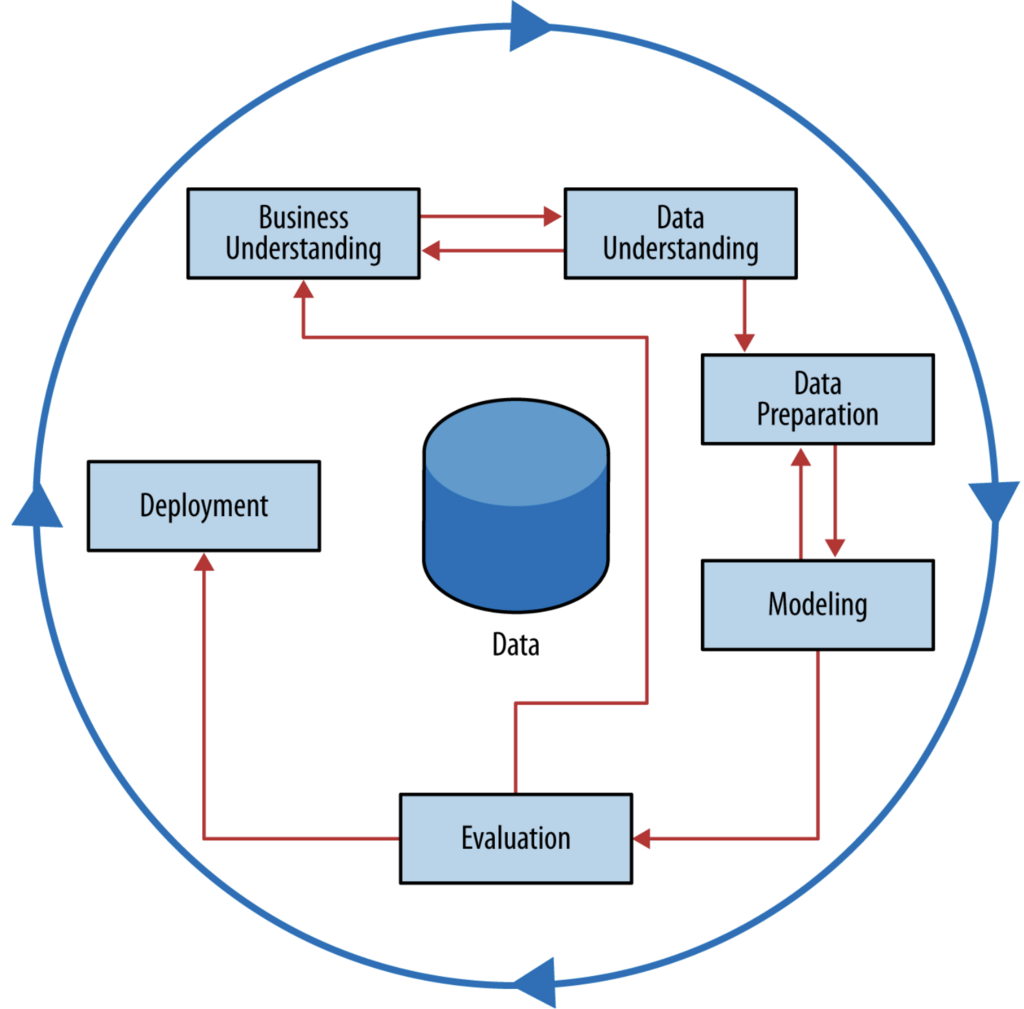In today’s data-driven economy, organizations are drowning in information while thirsting for actionable insights. The Cross-Industry Standard Process for Data Mining (CRISP-DM) emerges as the lighthouse guiding enterprises through the turbulent waters of data transformation, converting raw information into strategic competitive advantages that drive measurable business outcomes.
CRISP-DM’s proven methodology has established itself as the gold standard for data science initiatives, with nearly half of data professionals adopting this framework for their analytics projects. This widespread adoption stems from its ability to bridge the critical gap between technical data science capabilities and tangible business value creation, ensuring that every data mining project delivers measurable returns on investment.
The Six-Phase Framework for Data Success
Source: Fawcett, Tom & Provost, Foster. (2013). Data Science for Business.

Phase 1: Business Understanding – Foundation for Value Creation
The journey begins with crystal-clear business understanding, where organizations define their strategic objectives and translate them into measurable data mining goals. This phase serves as the crucial foundation, with research indicating that projects with well-defined business objectives are 70% more likely to succeed.
Strategic Value Creation:
- Clear articulation of business problems with quantifiable success metrics
- Alignment of technical capabilities with organizational strategies
- Establishment of realistic timelines and budget constraints based on complexity assessments
- Identification of subject matter experts and knowledge resources required throughout the project lifecycle
Phase 2: Data Understanding – Discovering Hidden Opportunities
Data understanding transforms raw information assets into strategic intelligence through comprehensive exploration and quality assessment. Organizations that invest adequately in data understanding reduce project risks by up to 60% and improve model performance significantly.
Key Deliverables for Maximum Impact:
- Comprehensive data inventories documenting all relevant sources and access methods
- Statistical analyses revealing patterns, relationships, and potential business insights
- Quality assessments identifying gaps and opportunities for improvement
- Preliminary hypothesis generation guiding subsequent modeling approaches
Phase 3: Data Preparation – Engineering Excellence
Often consuming 60-80% of project time, data preparation represents the critical phase where raw data transforms into modeling-ready assets. Organizations with robust data preparation pipelines achieve 40% faster time-to-market for data products.
Excellence Standards:
- Thorough documentation ensuring reproducibility and knowledge transfer
- Implementation of validation checks maintaining data integrity throughout transformation
- Creation of automated preparation pipelines enabling scalability
- Development of feature engineering strategies maximizing predictive power while maintaining business interpretability
Phase 4: Modeling – Turning Data into Predictive Power
The modeling phase applies sophisticated statistical and machine learning techniques to prepared datasets, with successful implementations balancing technical performance with business interpretability requirements. Companies leveraging advanced modeling techniques report 25% improvement in decision-making accuracy.
Strategic Implementation:
- Algorithm selection considering computational constraints and deployment environments
- Robust cross-validation procedures ensuring model generalizability
- Feature importance analysis providing actionable business insights
- Ensemble techniques improving performance while managing complexity tradeoffs
Phase 5: Evaluation – Ensuring Business Impact
Comprehensive evaluation ensures solutions meet both technical requirements and business objectives, with organizations implementing thorough evaluation processes achieving 35% higher project success rates.
Multi-Dimensional Assessment:
- Technical performance validation using domain-appropriate metrics
- Business impact assessment translating model performance into financial outcomes
- Risk assessment identifying potential failure modes and mitigation strategies
- Compliance verification ensuring regulatory adherence and organizational governance
Phase 6: Deployment – Delivering Sustainable Value
The deployment phase transforms analytical insights into operational business value through robust technical infrastructure and user adoption strategies. Organizations with effective deployment frameworks achieve 50% higher user adoption rates and 40% better long-term project sustainability.
Excellence in Implementation:
- Scalable technical architecture handling expected data volumes and processing requirements
- Comprehensive monitoring systems providing automated performance tracking
- Knowledge transfer protocols ensuring effective operational handover
- Feedback mechanisms enabling continuous improvement and adaptation
Economic Value and ROI Maximization
CRISP-DM’s structured approach is widely recognized for helping organizations create economic value by making data science projects more efficient, reliable, and aligned with business goals. While specific ROI figures can vary and are not always publicly documented, many organizations report that standardizing their analytics workflow with CRISP-DM leads to benefits such as improved project outcomes, reduced costs, and better resource allocation. Potential Value Drivers with CRISP-DM:
Revenue Generation Strategies:
- Enables data-driven product development, opening up new revenue opportunities
- Improves operational efficiency, which can help reduce costs
- Enhances customer segmentation and targeting, supporting more effective marketing
- Supports predictive maintenance and other use cases that can minimize downtime and operational losses
Cost Optimization Benefits:
- Helps reduce project failure rates through systematic risk management
- Accelerates time-to-market by providing a clear, repeatable process
- Improves resource allocation and project planning through structured phases
- Strengthens communication and collaboration between technical teams and business stakeholders, ensuring projects stay aligned with strategic objectives
While exact numbers will differ depending on the organization and use case, adopting CRISP-DM is generally associated with more consistent project delivery, better alignment with business needs, and the potential for measurable economic gains over ad-hoc approaches.
Future-Proofing Your Data Strategy
As artificial intelligence and machine learning continue evolving, CRISP-DM provides the stable foundation for adapting to new technologies while maintaining methodological rigor. Organizations leveraging CRISP-DM are better positioned to integrate emerging AI technologies and maintain competitive advantages in rapidly changing markets.
The methodology’s emphasis on business understanding and deployment ensures that technological innovations translate into measurable business outcomes, making it an essential framework for any organization serious about maximizing the value of their data assets
Conclusion
CRISP-DM represents more than a methodology—it’s a strategic imperative for organizations seeking to transform data into competitive advantage. By following this proven framework, enterprises can systematically reduce project risks, accelerate time-to-value, and ensure that every data science initiative contributes meaningfully to business success.
Comments